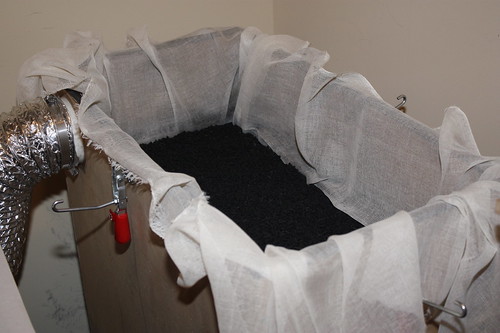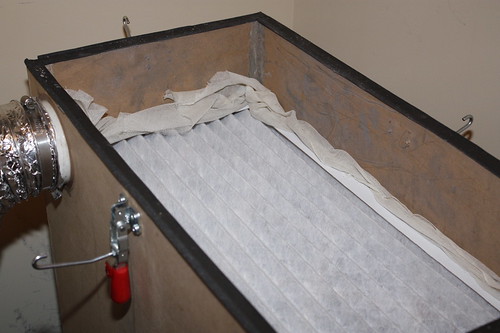I finally finished up my Homer Bucket Air Scrubber. Here are the materials I used:
5 Gallon Bucket (Home Depot, $2.57)
Lid (Home Depot, $1.28)
Dust Collector Accessory Kit (Harbor Freight, $38.39 with 20% coupon)
Contains:Flexible Hose, 4 x 10 (Qty 2)1/2" 12"x12" scrap plywood
Blast Gate-4 x 4 (Qty 2)
Jointer Hood-6 (Qty 2)
Y Fitting-4 x 4 x 4 (Qty 1)
Table Saw Dust Hood 12 x 12 (Qty 1)
Wire Hose Clamp (Qty 10)
12"x12" scrap window screen
12"x12" scrap 1/2" hardware cloth (1/2" metal mesh grid)
Carriage bolts, Nuts, Washers, 1/4" x 1/2" Stove bolts, 8x32 machine screws
15 lbs Activated Carbon Pellets (Amazon, $30)
==============================================
Using a 4" hole saw, drill a hole in the top center of the lid. (You can use a utility blade to cut the hole if you don't have a hole saw) Position one of the Jointer Hoods over the hole, drill four 1/4 mounting holes through the hood and lid, and secure using 1/4" stove bolts and washers. (You can use any bolts/washers you have laying around; 1/4" diameter x 1/2" long worked well.)
*Note: I did not silicone the jointer hood to the lid, however it is probably a good idea to do so to prevent air leakage. The bucket will be under negative pressure, so air won't leak out, but it will reduce the amount of suction at the laser if the bucket leaks air in. Eventually I'll put some silicone caulk between the hood and the lid.
Using a 4" hole saw, drill a hole in the bottom center of the bucket. Position one of the blast gates in the hole, drill mounting holes, and secure with machine screws. Again, you may want to silicone the gate to the bucket before final mounting.
You'll need to slice a small amount of the bucket bottom rim to accomodate the opening of the blast gate. A utility knife works fine if you score it a few times on the backside of the rim.
==============================================
You'll want an air space above the bottom of the bucket so you need to make a screen to hold the activated carbon above the bottom. I measured the diameter of the bucket about 3 inches off the bottom, cut a 1/2 inch plywood ring, and mounted four 3.5" carriage bolts to hold the ring up. I then cut some 1/2" hardware cloth (the 1/2 inch square screen you see in the photo) and mounted it on the top side of the ring. The hardware cloth will provide structural support for the screen that holds the carbon. Window screen went on top of the hardware cloth to prevent the carbon from falling through the hardware cloth. (The hardware cloth and screen are just stapled in place with 3/8 inch staples)
==============================================
Cut some inexpensive "cut to size" furnace filter and place it on top of the screen. This is just one more barrier to keep the carbon from falling through the screen and into the blower. The furnace filter had a flat side and a rough side. I placed the rough side down so the flat side would be against the carbon.
==============================================
Pour the activated carbon on top of the screen. I used 5 inches (about 15 pounds) of carbon. Here is a link to the carbon I used: http://www.amazon.com/gp/product/B000YIWT0M . It runs about $6 per 3 lbs. In total, I have five bags of carbon being used.
Place two more furnace filter rings on top of the carbon. This will catch any small bits (like paper). I placed the rough side of the filter towards each other, so the flat sides were against the carbon and towards the air inlet.
Here is a cross section of the filters and activated carbon. Above and below the blue filter media are air spaces.
==============================================
Here is the finished prototype. I cut a hole in an old mdf table to support the bucket, but the legs were too short to fit the hose at the bottom.Maybe this weekend I'll cut some longer legs. If I get really motivated, I'll eventually build a piece of furniture to house the scrubber and blower.
(Update: I have the exhaust setup so the laser connects to the scrubber at the top of the bucket, gets filtered through the bucket, then is pulled into the blower and then pushed out the window. Laser=> Scrubber => Blower => Window)
08_Complete.jpg
I'm using a Harbor Freight "green" blower (http://www.harborfreight.com/13-gall...tor-31810.html) and it's actually too much air flow through the scrubber with the blast gate on the bottom of the bucket fully open. Sliding it about 1/2 way closed seems to be the sweet spot: enough suction at the laser and doesn't let the burning smells through. The other side of the blower is exhausted out the window.
I did purchase some 4" elbows (http://www.amazon.com/gp/product/B0000223YE) to go at the top and bottom of the bucket, but the harbor freight hose is just a little too small to fit over the ends. I may go to Rocker and pick up some Dust Right® Quick Connect 4'' Elbows (http://www.rockler.com/product.cfm?p...8&site=ROCKLER) and a better quality hose (though it IS working just fine as is).




 Reply With Quote
Reply With Quote
 ) makes quite the racket. The higher pitched fan noise gets irritating if I leave the laser on for too long. I wish they had a setting on the 80w model to put the laser to sleep like they do on the 30w and under tubes.
) makes quite the racket. The higher pitched fan noise gets irritating if I leave the laser on for too long. I wish they had a setting on the 80w model to put the laser to sleep like they do on the 30w and under tubes.








